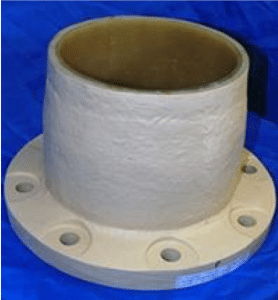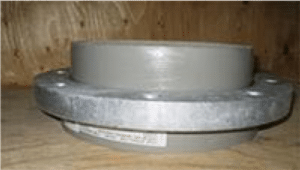What is a Full-Face FRP Flange?
A Full-Face flange is designed with a solid, circular face that spans the entire end of the pipe. This wide contact area is ideal for achieving a secure, reliable seal. Typically, full-face flanges are used in low-pressure applications, as their flat design helps ensure alignment and ease of installation.
Benefits of Full-Face FRP Flanges
- Improved Seal: The broad contact area ensures a tight seal, reducing the risk of leaks.
- Ideal for Alignment: Full-face flanges simplify alignment during installation, making them easier to work with.
- Consistent Performance: They are particularly effective in stable, low-pressure systems.
However, since full-face flanges cover the entire face, they tend to be more expensive and might not be necessary for every piping system.


Understanding Lap Joint FRP Flanges
Lap Joint (LJ) flanges consist of two parts: the stub end and the backing flange. The stub end connects to the pipe, while the backing flange can rotate, making alignment much easier. This design is popular for systems that need frequent maintenance or alignment adjustments.
Benefits of Lap Joint FRP Flanges
- Easy Alignment: The backing flange’s ability to rotate makes bolt alignment a breeze.
- Cost-Effective: With the option to use a backing flange made from less expensive materials like carbon steel, LJ flanges can be more budget-friendly.
- Flexible Material Choices: Because the backing flange doesn’t come into contact with the fluid, you can choose materials based on strength and cost, not corrosion resistance.
Lap Joint flanges are especially useful in applications requiring regular inspection and maintenance.


Full-Face vs Lap Joint FRP Flanges: Side-by-Side Comparison
| Feature | Full-Face (FF) Flanges | Lap Joint (LJ) Flanges |
|---|---|---|
| Design | Covers the entire face of the pipe. | Includes a rotatable backing flange and a stub end. |
| Alignment | Simple alignment due to full-face design. | Rotating backing flange simplifies bolt alignment. |
| Maintenance | Not ideal for frequent disassembly. | Easy to disassemble and reassemble for maintenance. |
| Pressure Applications | Best for low-pressure systems. | Suitable for low to moderate pressure systems. |
| Material Flexibility | Entirely FRP, suitable for corrosive environments. | Backing flange can be a different material for cost savings. |
| Cost | Generally higher due to more extensive use of FRP. | Cost-effective, especially with a carbon steel backing flange. |
Choosing the Right FRP Flange for Your Needs
So, how do you decide between Full-Face and Lap Joint FRP flanges? Consider your specific application. If your system requires a reliable seal with minimal maintenance, a full-face flange might be best. However, if you need flexibility, frequent adjustments, or cost savings, a lap joint flange could be the ideal choice.
Choosing between Full-Face and Lap Joint FRP flanges depends on your system’s unique requirements. Understanding the differences, benefits, and applications can help you optimize your piping setup for efficiency, reliability, and cost-effectiveness. For an additional discussion of FRP flanges, see Pressure Design of FRP Piping Components – Flanges in our Technical Center.
Selecting between Full-Face and Lap Joint FRP flanges depends on the specific requirements of the piping system, including pressure ratings, maintenance needs, and alignment considerations. Understanding the distinct features and advantages of each flange type ensures optimal performance and longevity of the piping system.
For a visual explanation of flange options for FRP piping systems, you may find the following video helpful: